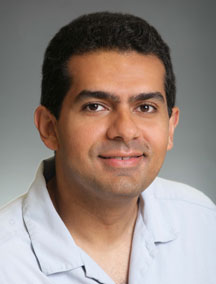

Getting From Here to There
By Eric Sauter
Not a lot is known about the moment when cell division—proliferation—stops and when cell differentiation—when the cell decides what it wants to be when it grows up—begins. That lack of knowledge has been a problem for cancer research. If the cell goes into proliferative overdrive and skips exiting the cell cycle (the sequence of growth and division of a cell), you get a rapidly dividing cell or cancer.
"There must be a reason why cells exit the cell cycle at a certain point, but only when we understand it thoroughly will we be able to tweak the machine to get the cells to stop dividing—and that would have tremendous potential," said Nagi Ayad, assistant professor in the Scripps Florida Department of Cancer Biology. "It has been done with transcription factors, but from a pure cell cycle perspective it's still unclear."
Scientists do know that the transition from division to differentiation takes places after the anaphase stage of mitosis—the division of chromosomes in the cell nucleus into identical chromosomal twins. The anaphase promoting complex or APC is a large multi-protein assembly activated during the anaphase stage. The APC targets a number of proteins for destruction, triggering a process that leads to the destruction of cohesion, a protein complex that holds together the chromatids—those identical DNA twins—ushering in the cell's exit from mitosis and onto the next stage of cell division, when the twins separate completely and two new cells are formed.
In a Journal of Biological Chemistry paper that was published online on December 1, 2008, and will appear in print in the February 13, 2009 edition (Volume 284, Issue 7), Ayad, who is one of only a handful of researchers looking at APC outside the cell cycle, has added an important new twist to what little is known about this essential complex in cell cycle exit.
"APC is such a critical complex that if you remove it from the cell cycle in organisms from yeast to man, the cell will die," he said. "It is absolutely essential. Our new study shows that this protein has a role in cell cycle exit, and that it responds to nerve growth factor in different cell types."
Deciding When to Leave
In the study, Ayad and his colleagues show that APC is required to coordinate differentiation programs with cell cycle exit, and that Skp2, a key APC substrate—the molecule acted upon—is critical to this response.
The study further suggests that the APC mediated degradation of Skp2 may be regulated by cues from nerve growth factor signaling. Nerve growth factor is a small secreted protein which induces the differentiation and survival of target neurons. (Newlyweds take note: In an interesting side study done in 2005, Italian scientists at University of Pavia found that when people first fall in love they exhibit high levels of nerve growth factor, but these levels return to normal after one year.)
"We found that APC is downstream from the nerve growth factor pathway, which is well known to induce differentiation into neuron-like cells," Ayad said. "If you inhibit APC activity you inhibit cell cycle exit and differentiation of the neuron. Our model is that the nerve growth factor activates APC, which then tags the APC substrate SKP2 for degradation. That action leads to an increase in the level of p27, a cell cycle inhibitor protein known to set the threshold for cell cycle exit and differentiation, particularly neuronal differentiation. The next big question is how does nerve growth factor actually talk to APC – we're working on that."
It has been a little over ten years since APC was first characterized as a highly regulated ubiquitin ligase—a protein that marks other proteins for destruction by the proteosome, a large protein complex in the cell that basically rip proteins into pieces, once described as garbage cans with teeth. APC appears to have multiple functions at different cellular locations, modulating diverse processes in addition to cell cycle regulation.
"What I hope our lab will be able to show over the next few years is that the decision to leave the cell cycle is made early on," said Ayad. "The decision point, prompted by nerve growth factor or some other kind of differentiation factor, can't be at the last mitotic division and it's out."
Ayad and his colleagues are also taking the next step in the process, looking for small molecule probes to inhibit degradation of certain proteins that work in the cell cycle and that might be useful in cancer therapy.
The first authors of the study, The Anaphase Promoting Complex Induces Substrate Degradation during Neuronal Differentiation, are Dympna Harmey and Anthony Smith of The Scripps Research Institute; other authors include Scott Simanski and Carole Zaki Moussa, also of Scripps Research. See
http://www.jbc.org/cgi/content/abstract/M804944200v1.
The study was supported by the Margaret Q. Landenberger Foundation and the State of Florida.
Send comments to: mikaono[at]scripps.edu

"Only when we understand [cell cycle exit] thoroughly will we be
able to tweak the machine to get the cells to stop dividing—and that would
have tremendous potential," says Assistant Professor Nagi Ayad.
